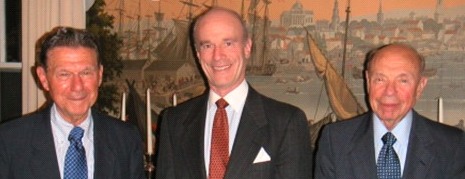|
|
The
Armand V. and Donald S. |
|
|
|
Converging Technologies at Union The Humanities and
Technology: Building Bridges Thank you for inviting me to speak on this occasion. I apologize for having to leave immediately after my talk, but Philosophy has an outside speaker this afternoon who is due to arrive at my office door at 4:00. 1. I was asked to speak briefly about the Dept of Philosophy’s plans and projects, and wishes, for its involvement in Converging Technology. First a little history:
2. If all of this creates the impression that it is easy for philosophy to embrace CT enthusiastically, perhaps easier for philosophy than for most other departments in the Humanities, I think that’s right. It is easier. The reason is that CT, under one of its major guises, simply means an interdisciplinary approach and philosophy is interdisciplinary to the core. From the perspective of philosophy, a link with other disciplines, especially the sciences, is inevitable. It’s hard to do philosophy without making that link. Bridges do not have to be built linking philosophy with science. They already exist. In one way or another, most philosophers walk back and forth across those bridges every day of their professional lives. Historically, technology has not been as closely linked with philosophical thought, but from about the 1950s, and increasingly, it is becoming closely linked. Currently a great deal of philosophical theorizing in logic, philosophy of mind, and ethics is done with a close eye on technological connections and applications. 3. An objection that one sometimes hears to CT from scientists and engineers is that implementing it would require trading depth for breadth. This is not a complaint that you will ever hear from philosophy. Our linking with other disciplines is not a matter of trading breadth for depth. It is a matter of achieving depth. It would be easy to give many examples of what I mean by this, but for now one example, from a recent book, will have to suffice. The author is Owen Flanagan, a prominent philosopher of mind at Duke. His project is to develop what he calls a naturalized theory of the self. He writes: The story of how a conceptus becomes a fetus that becomes a viable human infant is well understood. But how a human infant acquires a sense of self, becomes a person, establishes an identity, and eventually gets in touch with this identity is less well understood. The sequencing of the human genome may add to our understanding of this process, especially in the early stages of the development of the self. But genetics is not likely to be a major player in explaining the self. Selves emerge in embodied organisms living in multifarious social environments. And despite much hoopla, neither sociobiology nor the new evolutionary psychology displays remotely adequate resources to explain, on its own, the varieties of social worlds that exist and that contribute significantly to self-emergence. Nonetheless, a plausible theory of the self is coming into view, thanks to the combined efforts of philosophy, child psychology, cognitive neuro-science, evolutionary psychology, sociology, and anthropology, as well as work in literary theory on narrative. (from The Problem of the Soul (New York: Basic Books, 2002), pp. 217-18) In the next forty pages, Flanagan goes on to explain how each of these disciplines has contributed to a theory of the self. This example is typical of the way philosophy of mind is done these days. 4. Most analytic philosophers see what they are doing as not only linked with science, but continuous with science. What this means is that, in their view, if one walks the bridge between philosophy and science one reaches a point where what one is doing is as much science as it is philosophy. If this idea is correct, as I think it is, it has an important implication for the CT initiative at Union College. It means, I think, that the physical sciences and engineering should also be able to move in the direction of philosophy without trading depth for breadth, in fact their doing this may actually augment the depth of training that they give majors in their own disciplines. How could this happen? By their including as a part of some science and engineering courses a section in which teachers address the question of how their particular discipline generates knowledge. In other words, teachers can turn their attention from employing their distinctive methodologies to produce knowledge to examining their methodologies themselves and the assumptions which underlie them. Every methodology in every discipline rests on usually unspoken assumptions. Often great advances occur in the sciences by someone’s making one or more of these assumptions explicit and calling it (or them) into question. It is not a crazy idea to suppose that science students in particular could develop a deeper understanding of their own disciplines by trying to make the assumptions that underlie the ways they are acquiring, or trying to acquire, knowledge explicit and then subjecting those assumptions to critical scrutiny. This is often done in instruction in the social sciences, particularly in sociology. It is sometimes, but not as often, I think, done in instruction in the physical sciences. It could be done more often. If science teachers, for instance, did this, they would be reflecting on their own methodologies in a way that is indistinguishable from what is called a “bottom up” approach to philosophy of science. Arguably their going this route would be a way not of trading depth for breadth, but of their giving their students a deeper engagement with their own disciplines. It is sometimes said, with considerable justification, that the trouble with philosophy is that its done by philosophers. But whose fault is that? A Ways of Knowing initiative, as part of Union College’s CT program, could begin to redress the imbalance. Thank you.
Ray Martin |
|

